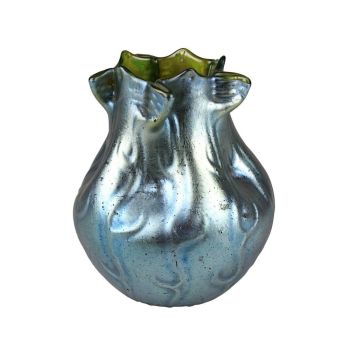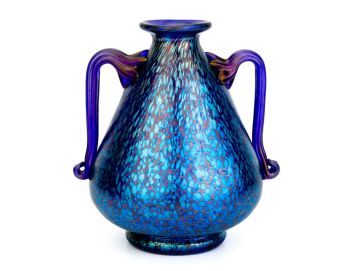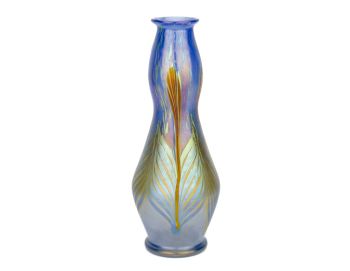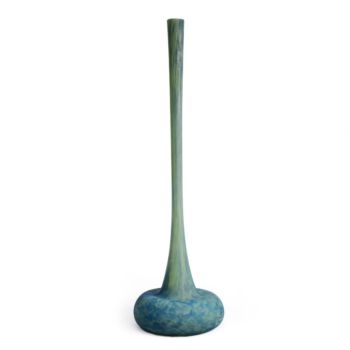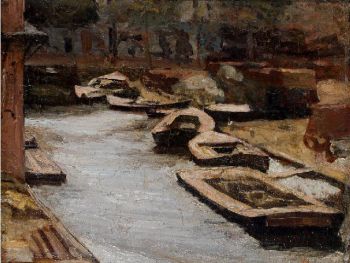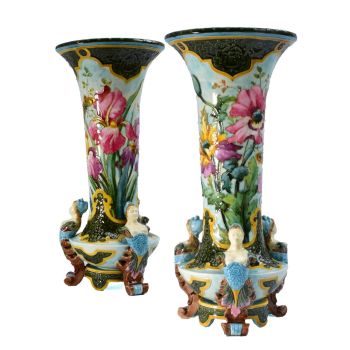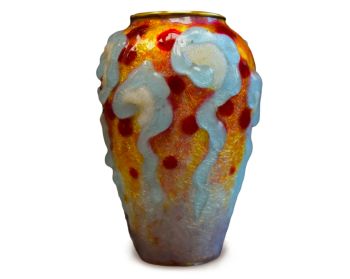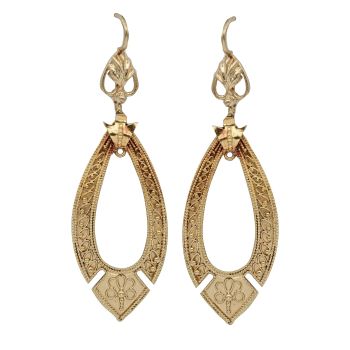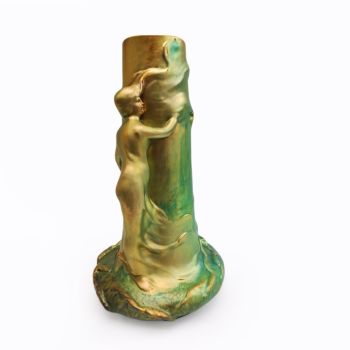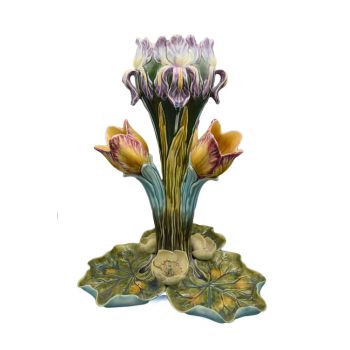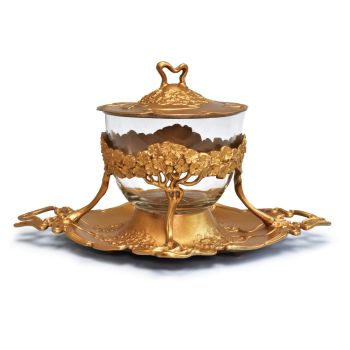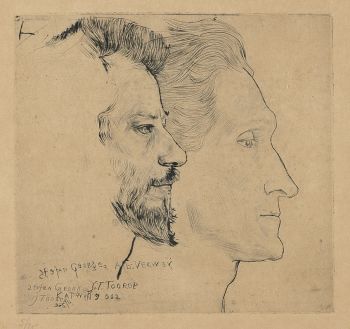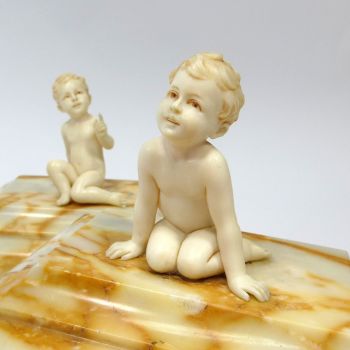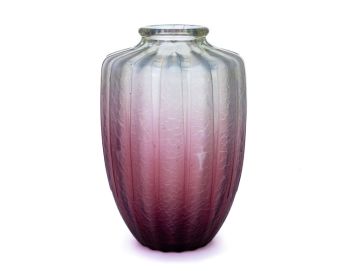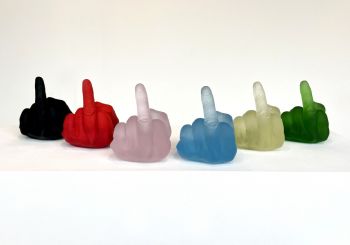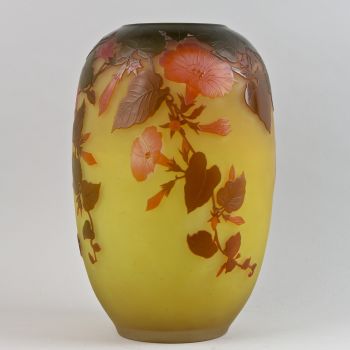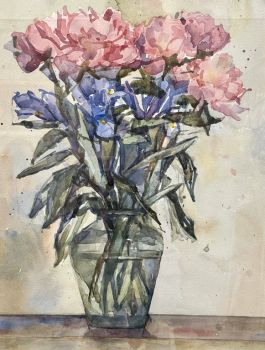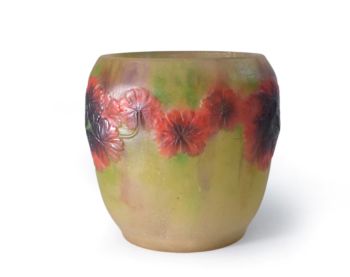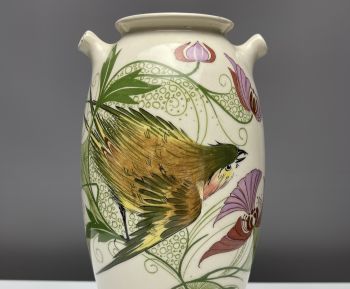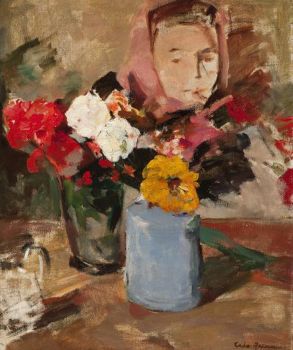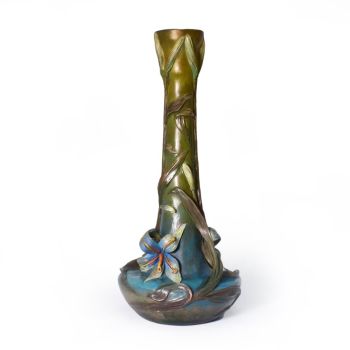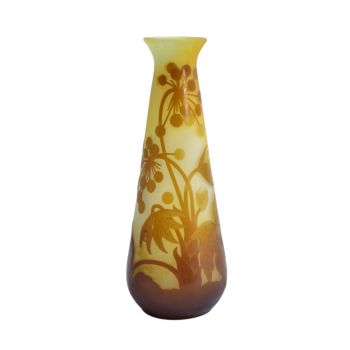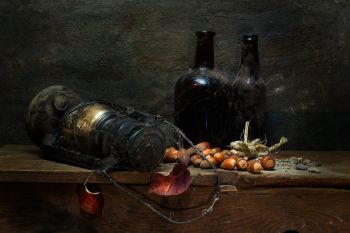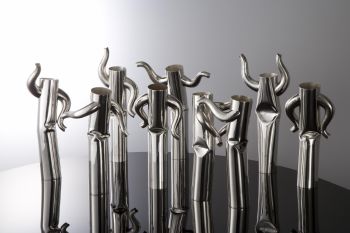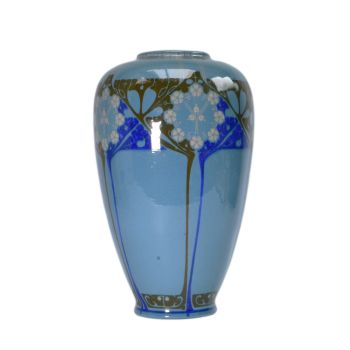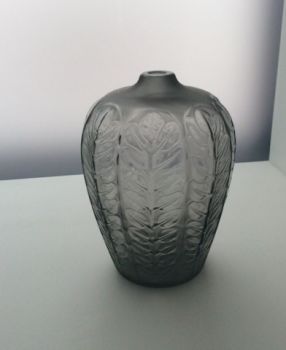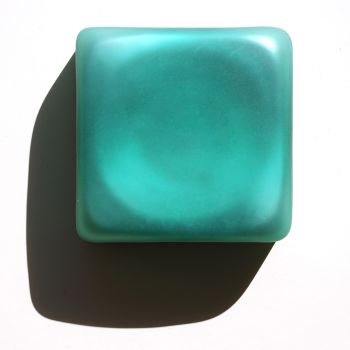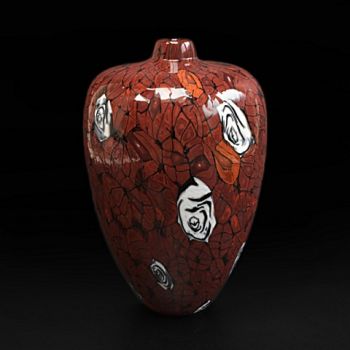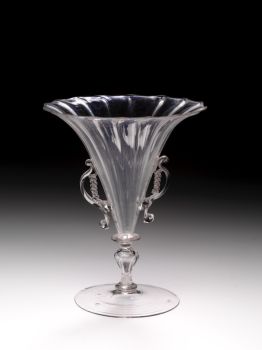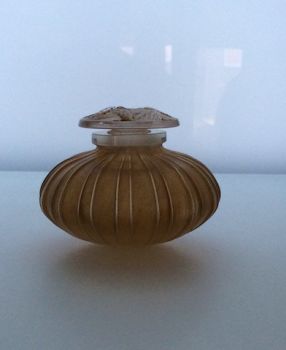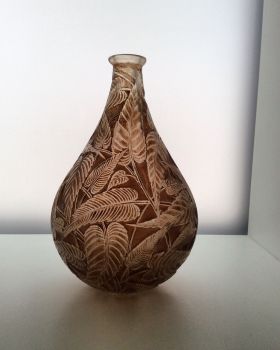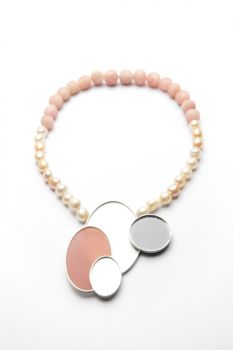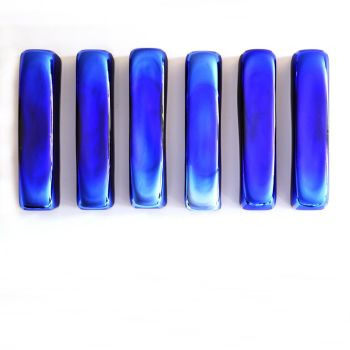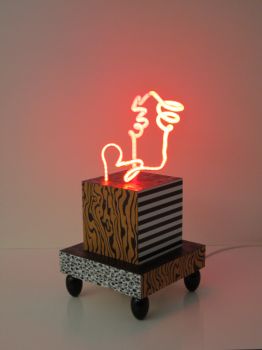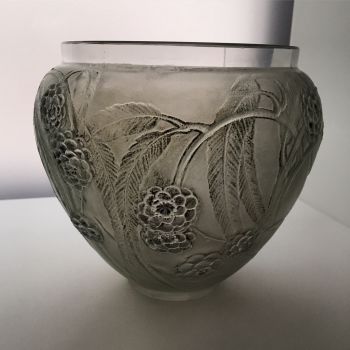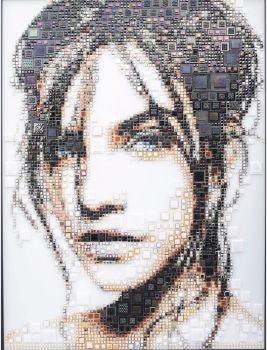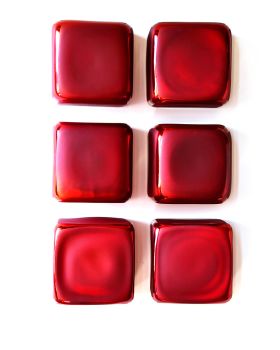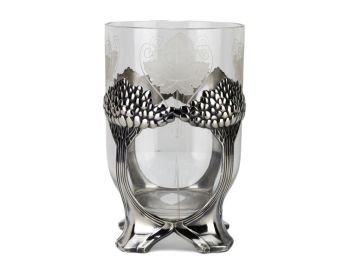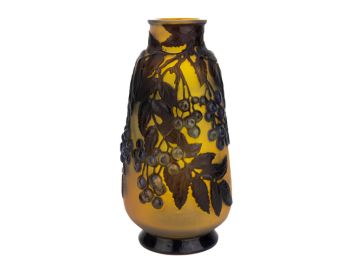Johann Loetz Witwe – Boudon & Klähr, Paris, 1900 – Ruby Papillon – Art Nouveau mount 1900 - 1909
Johann Loetz (Lötz) Witwe Klostermühle
Glas
17 ⨯ 13 cm
ConditionMint
Prijs op aanvraag
Antiques Emporium
- Over kunstwerkThis vase is our second mounted vase from Boudon & Klähr in Paris. This vase or bowl was created in the heyday of Art Nouveau around 1900 – 1905 through a collaboration between Johann Loetz Witwe from Austrian Bohemia and Boudon & Klähr from Paris. This creation is a perfect marriage of Austrian Jugendstil and French Art Nouveau.
The vase was blown by Johann Loetz Witwe in a ground color of ruby red glass and is executed in the decor “Papillon”. This decor made its appearance in the year 1898 and is one of the most famous, successful and probably also one of the most applied decors by Johann Loetz Witwe. Papillon is characterized by iridescent dots that change color depending on which ground color the vase is blown (Crete, Candia, Cobalt or Ruby).
Boudon & Klähr which was based in Paris represented Johann Loetz Witwe’s glass in the French capital. This vase that was sold exclusively by Boudon & Klähr, therefore, is an excellent representation of Austrian Art Nouveau glass combined with a pewter mount in French Art Nouveau design.
The literature indicates that the glass for this vase was commission-ordered from Johann Loetz Witwe by Boudon & Klähr; it is unknown by which firm the pewter frame was applied to the commission-ordered vases. In some cases Gustav Gurschner is attributed as the designer, although no incontrovertible evidence for this has been found.
Dimensions:
Height: 175mm / 6.89”
Diameter top: 130mm / 5.12″
Width mount: 265mm / 10.43″
Literature:
Prestel – Böhmisch Glas 1880 – 1940 Band 1 Werkmonographie. Page 98 & 99. - Over kunstenaar
Lötz/Loetz werd in 1840 opgericht door Johann Lötz en was een bedrijf gevestigd in Bohemen, in de Tsjechische Republiek, in de tijd dat Lötz tot het keizerrijk Oostenrijk-Hongarije behoorde. In 1879 nam een kleinzoon van Lötz, Max Ritter-Von Spaun, de zaak over van zijn grootmoeder en hield de naam Joh. Lötz Witwe.
Vanaf dat moment begon Johann Lötz Witwe echt naam te maken, ze ontwikkelden nieuwe innovatieve glastechnieken, maar ook hun vormgeving en felle kleuren waren helemaal vernieuwend. Ze ontwierpen bijzondere vormen en vazen, luxe artikelen, die ze verkochten in luxe winkels in Wenen, Berlijn, Hamburg, Parijs, Londen, Milaan, Brussel en Madrid. Het maakte ze al snel zeer bekend en beroemd.
Het was de periode dat de Art Nouveau of zoals dat in Duitsland Jugendstil genoemd werd, bloeide. Ze gebruikten organische vormen, de natuur was hun voorbeeld, ook voor Lötz ontwikkelden ze prachtige decors, gelijkend op vlindervleugels, zoals het papillondecor van deze vaas, vaak werden de vormen organisch gevormd door met een tang het hete glas ongelijk te vormen, evenals bloemen worden gevormd. Maar ook een octopus of zeeschelpen werden als voorbeeld genomen voor hun bijzondere vazen en decors.
Lötz nam deel aan allerlei Wereldtentoonstellingen, waaronder de beroemde Wereldtentoonstelling van 1900 in Parijs waar ze de Grote Prijs wonnen. Ze werden bekroond met tal van prijzen voor deelname aan Wereldtentoonstellingen. Max Ritter von Spaun ontving ook speciale onderscheidingen voor zijn bijdrage aan de glasindustrie, in 1883 mocht hij de keizerarend in hun schild en zegel gebruiken, ze mochten ook K.K. Zet Private Glass Factory voor hun naam. In 1889 ontving hij ook een ridderschap van Franz Josef. Maar ook andere koningshuizen waren erbij betrokken. Hij ontving de Belgische Leopoldsorde en het eervolle Franse Legion d'Honneur.
Hun ontwerpen vielen in de smaak, ook in de Verenigde Staten. Tiffany werkte met Lötz aan de set van Favril. Lötz patenteerde enkele van hun speciale technieken, zoals degene die ze gebruikten om het Phänomen-decor te maken. Ze waren in staat iriserend glas te maken. Kortom, Lötz was een begrip geworden. En dat is het nog steeds.
Lötz werkte ook nauw samen met andere glasfabrikanten zoals J.&L. Lobmeyer en E. Bakolowits Söhne in Wenen en met Argentor. Daarnaast werkte Lötz nauw samen met verschillende kunstenaars, zoals Josef Hoffmann, Koloman Moser, Franz Hofstötter, Michael Powolny en andere kunstenaars van de Wiener Werkstätte. Michael Powolny was verantwoordelijk voor de veel strakkere tangovazen uit de jaren twintig.
De Eerste Wereldoorlog en het einde van het Oostenrijkse rijk betekenden een moeilijke periode voor Lötz.
Lötz heeft bestaan tot 1940, na een bombardement is de fabriek volledig afgebrand. Na de Tweede Wereldoorlog behoorde Tsjechië tot de satellietstaten van de Sovjet-Unie, de fabriek werd genationaliseerd totdat deze uiteindelijk in 1947 werd gesloten.Het glas van Lötz is nog steeds erg populair en wordt wereldwijd verzameld, daarnaast is hun oeuvre ook terug te vinden in vele museumcollecties.
Bent u geïnteresseerd om dit kunstwerk te kopen?
Artwork details
Related artworks
Johann Loetz (Lötz) Witwe Klostermühle
Johann Loetz Witwe - Phänomen Genre 7773 – Orange1900 - 1910
Prijs op aanvraagAntiques Emporium
Johann Loetz (Lötz) Witwe Klostermühle
Johann Loetz Witwe – Ausfuehrung 146 Titania vase – 19121910 - 1919
Prijs op aanvraagAntiques Emporium
Johann Loetz (Lötz) Witwe Klostermühle
Johann Loetz Witwe – Jugendstil Cobalt Papillon vaas1900 - 1910
Prijs op aanvraagAntiques Emporium
1 - 4 / 7Firm Erhard & Sohne, Schwäbisch Gmünd
Erhard und Söhne – Jugendstil intarsia klok – 1908 / 19091900 - 1909
Prijs op aanvraagAntiques Emporium
Johann Loetz (Lötz) Witwe Klostermühle
Johann Loetz Witwe – Jugendstil Cobalt Papillon vaas1900 - 1910
Prijs op aanvraagAntiques Emporium
1 - 4 / 24Demetre Chiparus
Demetre H. Chiparus – Bronze Art Deco statue “Rapture” – Édition Etling, Paris1920 - 1929
Prijs op aanvraagAntiques Emporium
Amalric Walter
Amalric Walter & Henri Bergé – Crabe plumier1920 - 1929
Prijs op aanvraagAntiques Emporium
Johann Loetz (Lötz) Witwe Klostermühle
Johann Loetz Witwe - Phänomen Genre 7773 – Orange1900 - 1910
Prijs op aanvraagAntiques Emporium
Gabriel Argy-Rousseau
Gabriël Argy-Rousseau – Crabes et Algues vase – 19201920 - 1929
Prijs op aanvraagAntiques Emporium
1 - 4 / 24- 1 - 4 / 24
Onbekende Kunstenaar
Venetiaans Gevleugeld Glas1550 - 1599
Prijs op aanvraagPeter Korf de Gidts - Antiquairs
Onbekende Kunstenaar
An Indian part-gilt silver-clad ceremonial sceptre or mace with a tiger’s head1850 - 1900
Prijs op aanvraagZebregs & Röell - Fine Art - Antiques
 Gecureerd door
Gecureerd doorDanny Bree
1 - 4 / 24Johann Loetz (Lötz) Witwe Klostermühle
Johann Loetz Witwe - Phänomen Genre 7773 – Orange1900 - 1910
Prijs op aanvraagAntiques Emporium
Johann Loetz (Lötz) Witwe Klostermühle
Johann Loetz Witwe – Jugendstil Cobalt Papillon vaas1900 - 1910
Prijs op aanvraagAntiques Emporium
Firm Erhard & Sohne, Schwäbisch Gmünd
Erhard und Söhne – Jugendstil intarsia klok – 1908 / 19091900 - 1909
Prijs op aanvraagAntiques Emporium
Amalric Walter
Amalric Walter & Henri Bergé – Crabe plumier1920 - 1929
Prijs op aanvraagAntiques Emporium
Johann Loetz (Lötz) Witwe Klostermühle
Johann Loetz Witwe – Ausfuehrung 146 Titania vase – 19121910 - 1919
Prijs op aanvraagAntiques Emporium
Gabriel Argy-Rousseau
Gabriël Argy-Rousseau – Crabes et Algues vase – 19201920 - 1929
Prijs op aanvraagAntiques Emporium
Onbekende Kunstenaar
François-Théodore Legras – Tall “Fleurs de Pommier” apple blossoms vase1900 - 1909
Prijs op aanvraagAntiques Emporium
1 - 4 / 12

















